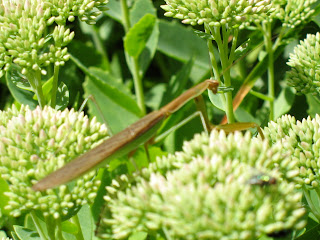The strawberries in our front garden were just starting to blush. Meanwhile, five pounds of rhubarb were awaiting my hand. So on my day off, in 80+ New England weather, I became the Rhubarb Goldberg Machine, slicing, dicing, boiling, simmering, pickling, and baking. I even broke some eggs and brought out the crushed red pepper and local honey.
Here are four new, original recipes using rhubarb without the tardy strawberries. They are sweet, tangy, creamy, and tart. Bread pudding, a classic butter tart, and more to follow...
Here are four new, original recipes using rhubarb without the tardy strawberries. They are sweet, tangy, creamy, and tart. Bread pudding, a classic butter tart, and more to follow...
Gluten-Free/Vegetarian/Vegan Option
________________________________________________
Rhubarb Compote
Taste of France
________________________________________________
2 1/2 cups rhubarb, sliced 1/2” thick (about 5 stalks)
1/4 cup plus 2 tbs. water
1/4 cup brown sugar
1 tbs. local honey (optional for vegan recipe)
2 tsp. corn starch
1/4 cup finely chopped walnuts (optional)
1 tsp. lemon zest
Dissolve corn starch with 2 tbs. water. Mix with all ingredients except nuts. Heat in a heavy saucepan over medium-high heat, stirring constantly, about 2 minutes. Reduce heat and simmer 10 minutes. Stir in nuts and cook 5 more minutes. Serve at room temperature or slightly chilled.
Gluten-Free/Vegan
________________________________________________
Rhubarb Pickles
Taste of Earth
________________________________________________
1 1/2 cups white vinegar
3/4 cups sugar
7 whole cloves
1/4 tsp. crushed red pepper
10 stalks of rhubarb, cut to 3” lengths
2 pint-size mason jars
In small sauce pan, dissolve sugar into vinegar and bring mixture to boil. Add cloves and red pepper and simmer 10 minutes. Keep two sanitized mason jars in a bowl of hot water in preparation. Fill each jar with half the rhubarb stalks. Pour vinegar mixture over stalks and secure lids. (Leave a half-inch of space if canning. Can in hot water bath ten minutes.) For immediate use, let cool on towel on counter, then refrigerate overnight.
Vegetarian
________________________________________________
Rhubarb Goldberg Machine
Taste of Earth
________________________________________________
1 1/2 cup unbleached flour
1/2 cup white sugar
2 tsp. baking powder
1/2 tsp. salt
1/4 cup butter, melted
2 eggs
1 cup strawberry yogurt
1/4 cup buttermilk
1 cup rhubarb stalks, sliced 1/4” thick
1 cup old-fashioned oats
1/4 cup sliced almonds
This muffin has it all, but bakes light and refreshing. Melt butter. Whisk in eggs, then yogurt and buttermilk. Sift dry ingredients. Mix in rhubarb, oatmeal, and nuts. Stir wet ingredients into dry until just moistened. Fill 12 greased muffin tins. Bake at 400ºF 20-25 minutes.
________________________________________________
Creamy Cold Rhubarb Soup
Taste of Norway
________________________________________________
5 rhubarb stalks, peeled (reserving peel for stock) and sliced
1/4” thick
3 small pieces of cinnamon bark (or substitute cassia)
3 cups water
1/2 cup white sugar
1 tsp.chopped lemon thyme leaves, reserving stems
1 tsp. chopped mint leaves, reserving stems
1 cup buttermilk
Combine rhubarb peelings, cinnamon, sugar, herb stems, and water in medium sauce pan. Bring to boil. Reduce heat and simmer 10 minutes. Strain liquid into bowl, compost remaining solids, then return liquid to pan. Add rhubarb pieces, bring to boil again, then remove from heat. Stir in buttermilk. Cool completely. Serve cold, garnished with chopped mint.













